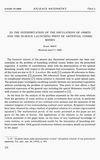Article
Full entry |
 PDF
(1.1 MB)
Feedback
PDF
(1.1 MB)
Feedback
 PDF
(1.1 MB)
Feedback
PDF
(1.1 MB)
Feedback
Keywords:
mechanics of particles and systems
mechanics of particles and systems
Summary:
The case of transferring the rocket from the prescribed path of departure to the transfer orbit osculating another given complanar rocket trajectory of arrival is studied. The introducing to the transfer orbit is realized only by a change of the modulus of velocity of the rocket without changing the flight direction. The requirement of osculating the two conic sections leads to a solution of an algebraic-trigonometric system which is numerically labourious. The prescription of the position of the apsidal line of the transfer orbit is a simplification which makes possible an explicit expression of the polar angles of the osculating points. The starting velocity is expressed and related to any arbitrary point of the original path by the assignement of the real solution. The purely geometrical approach to the problem is made as well, without kinematic attitude. The conclusion investigates a cosmical rendez-vous, i.e. the case when a rocket flying along the transfer path finds the rocket moving along the trajectory of arrival.
References:
[1] D. F. Lawden: Optimal Trajectories for Space Navigation. London, Butterworths 1963. MR 0199011 | Zbl 0111.19605
[2] G. Leitmann (editor): Optimization Techniques with Applications to the Aerospace Systems. New York, London, Academic Press 1962. MR 0153501
[3] D. F. Lawden: Chapter XI in [2]. Zbl 0775.70040
[4] W. Hohmann: Die Erreichbarkeit der Himmelskörper. München, Oldenbourg 1925.

